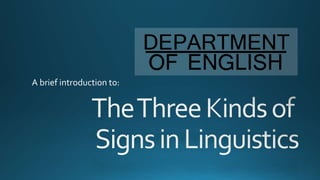
The three kinds of Signs in Linguistics
- 1. A brief introduction to:
- 2. • The main purpose of this presentation is to learn which are the three kinds of signs in linguistics, which are: Iconic signs Indexical signs Symbolic signs • We will also learn their definitions, and how to decipher each one.
- 3. Definition: An action, gesture or symbol, that is regularly associated with a particular concept. Nevin Leder mentions in his text Introduction To Linguistics that “the term “sign” has multiple meanings, and linguistic signs are quite different from other kinds of signs in ways that are important for our understanding of language. We all understand that a sign of any kind is something that points to or “stands in” for something else. In technical language we say signs represent the objects they stand for” (2012)
- 4. Definition: Determined by chance, whim, or impulse, and not by necessity, reason, or principle. “Linguists have surveyed the words of the world’s languages and have discovered conclusively, that nearly all the words in all languages are arbitrarily related to the concepts they represent” (Leder, 2012)
- 5. Charles Sanders Peirce (1839-1914) was the man responsable in devising the three-way división of signs widely recognized in linguistics as Iconic, Indexical and Symbolic.
- 6. -Iconic signs are intended to resemble what it represents. It does not have to be very accurate representations of what it represents. Examples of iconic signs include: • Certain road signs such as a sign with an S curve on it with the intended meaning “road curves ahead”. • Signs with a trash can drawn, indicating a trash can is available there. • Onomatopoeic words such as words for the noises animals make (Meow, Kikiriki! Woof! etc.), or words for loud noises, such as “Blam!” for the sound of a gun. -Truly iconic signs are the least common of the three.
- 7. Signs that are non-arbitrarily associated with that they represent. -Indexical signs are signs that acquire their function through a causal connection with what they signify, containing an indirect connection with what it represents, and what it signifies. Examples of Indexical signs are: • A road sign of a knife and fork that tells a driver there is a restaurant ahead. • A road sign depicting a bed, indicating there is a hotel ahead. • A sign showing a toothbrush outside of a building, indicating that there is a • dentist there. • A sign at the beach showing a shark fin surfacing out of a ripple of water, meaning that the beach is dangerous because it may contain sharks. -Indexical signs are the second most common kind of sign.
- 8. -Symbolic signs are arbitrarily related to what they represent, like most words in all language, which means, there is no logical or natural connection between most words and the concept they represent. Example of a Symbolic sign would be: • the word for love is “amor” in Spanish, “agape,” “philia,” or “eros” in Greek (depending on what kind of love), “liebe” in German, and there are thousands of other words for “love” in other languages. -Given that all of these words express the concept equally well, and the same is true for nearly all other words, with the exceptions noted above, linguists conclude that the relationship between words and concepts in natural languages is usually arbitrary.
- 9. -A Hybrid sign is a special kind of sing that contains elements of more than one type of sign. Example: • A sign containing an image of a tooth, and under that has the words “Dentist” would be a hybrid because it has a picture of a tooth, meaning it has indexical features, an indirect relationship to a dentist, and it is also symbolic because it contains the word dentist which is arbitrary to the concept of a dentist, meaning that the only way to know what the word “dentist” means is if we learn it manually.
- 10. As you now have learned, there exist a three-way division between signs, dividing them into three categories which are: Indexical, Iconic and Symbolic. On special occasions, a sign might also be hybrid, containing two or more elements of types of signs. We have signs surrounding us all the time: on the road, on the T.V., in the internet, on a product, on a sign at a local shop, etc… With this knowledge, you can now be able to decipher what kind of sign you are looking at, and what is it trying to accomplish.